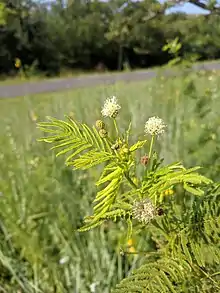| Desmanthus illinoensis | |
|---|---|
 | |
| Desmanthus illinoensis | |
 | |
| Desmanthus illinoensis flower heads | |
| Scientific classification | |
| Kingdom: | Plantae |
| Clade: | Tracheophytes |
| Clade: | Angiosperms |
| Clade: | Eudicots |
| Clade: | Rosids |
| Order: | Fabales |
| Family: | Fabaceae |
| Subfamily: | Caesalpinioideae |
| Clade: | Mimosoid clade |
| Genus: | Desmanthus |
| Species: | D. illinoensis |
| Binomial name | |
| Desmanthus illinoensis (Michx.) MacMill. ex B. L. Rob. & Fernald[1] | |
| Synonyms[2] | |
| |
Desmanthus illinoensis, commonly known as Illinois bundleflower, prairie-mimosa or prickleweed, is a common plant in many areas of the south central and Midwestern US.
Habitat
It can often be found growing on the sides of roads, particularly on southern exposures, needing full sun and ample moisture during its short growing season. The mature plants often grow and flower in mowed areas. In many parts of its native habitat, road sides are only mowed twice a year. In the late spring and again in late fall. The early mowing helps clear away competitors that might impede growth. The late mowing chops up the dry seed pods resulting in some scarification and resulting in better germination.
USDA Zones 5-8 are recommended for outside cultivation. The waxy seed coat needs to be scarified prior to planting.
Chemistry
Root bark of D. illinoensis has been found to contain N,N-DMT, NMT, N-hydroxy-N-methyltryptamine, 2-hydroxy-N-methyltryptamine, and gramine (toxic).
Nutritional benefits
The plant is nutritious and high in protein.[3]

The Land Institute in Salina, Kansas has done extensive research into the food uses of the seeds of this plant. Studies found the dry seeds composed of 38% protein, compared to 40% for soybeans.[4]
Ayahuasca analogue
To produce prairiehuasca, the root bark is mixed with a native source of beta-Carbolines (e.g., passion flower in North America) to produce a hallucinogenic plant concoction analogous to the shamanic South American brew ayahuasca.[5]
References
- ↑ "Desmanthus illinoensis". Germplasm Resources Information Network. Agricultural Research Service, United States Department of Agriculture. Retrieved 2008-04-27.
- ↑ "The Plant List: A Working List of All Plant Species". Retrieved 26 June 2015.
- ↑ Niering, William A.; Olmstead, Nancy C. (1985) [1979]. The Audubon Society Field Guide to North American Wildflowers, Eastern Region. Knopf. p. 527. ISBN 0-394-50432-1.
- ↑ "Illinois Bundleflower: Prospects For A Perennial Seed Crop". landinstitute.org. Retrieved 2017-05-08.
- ↑ Hegnauer, R.; Hegnauer, M. (1996). Caesalpinioideae und Mimosoideae Volume 1 Part 2. Springer Science & Business Media. p. 199. ISBN 9783764351656.
External links
 Media related to Desmanthus illinoensis at Wikimedia Commons
Media related to Desmanthus illinoensis at Wikimedia Commons- Erowid Desmanthus Vault